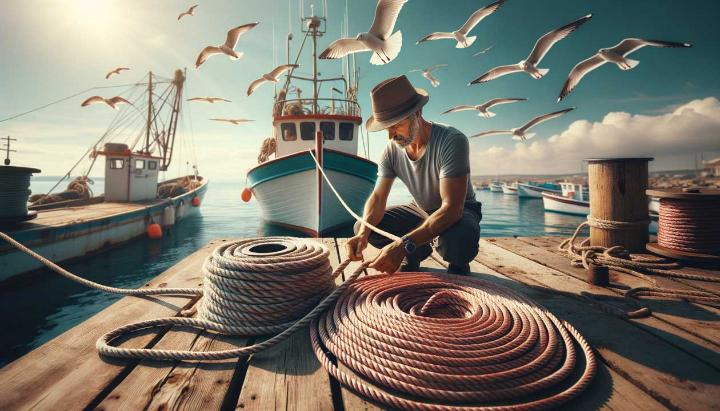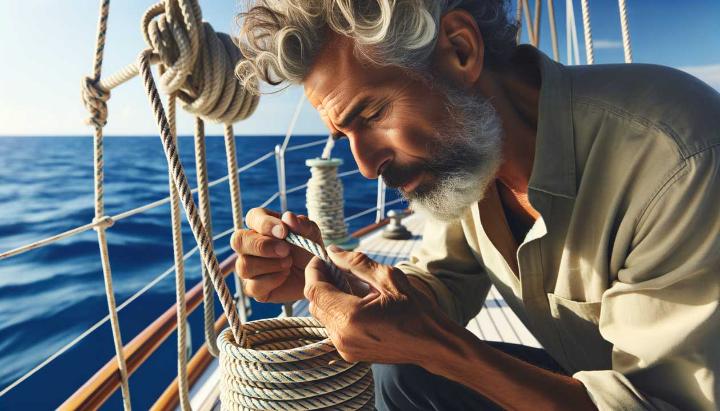Ever wondered what makes certain ropes indispensable in maritime applications? The secret often lies in their construction. From battling the fierce ocean waves to ensuring vessels stay securely moored, the type of rope you choose can make all the difference. Let's delve into the fascinating world of 3 strand braided ropes and 8 strand ropes—two champions in the marine industry that offer unique advantages tailored to the sea's demands.
iRopes, a premier Chinese rope manufacturer, has mastered the art of crafting these high-quality ropes. Specialising in creating tailor-made solutions for diverse industries, iRopes guarantees not only durability and strength but also customisation that aligns perfectly with specific maritime needs. With an unwavering commitment to precision and quality assurance, backed by ISO 9001 certification, iRopes caters to wholesale customers worldwide who require reliable rope solutions.
Join us as we explore the intricate structures and benefits of the 3 strand braided rope and the 8 strand rope—essentials for ensuring safety, efficiency, and performance at sea. Whether you’re a seasoned sailor or a marine enthusiast, understanding the nuances of these ropes will help you make informed choices for your maritime ventures.
Understanding the Structure of a 3 Strand Braided Rope
Have you ever marveled at the intricate design of a 3 strand braided rope? These ropes are a true marvel of engineering, combining durability and strength with a sleek, braided construction. Imagine running your fingers along the twisted strands, feeling the smooth texture and the tightness of the braid. It's a testament to the craftsmanship and precision that goes into their creation.
What is a 3 Strand Braided Rope?
A 3 strand braided rope is a type of rope that, as the name suggests, is composed of three strands twisted together in an intricate braid. These ropes are widely used in maritime applications due to their exceptional strength, resistance to abrasion, and ability to withstand harsh marine environments.
Common materials used in the construction of 3 strand braided ropes include polyester, nylon, and polypropylene. Each material offers unique advantages, such as high tensile strength, resistance to chemicals or UV rays, and buoyancy, making them suitable for different maritime applications.

How is a 3 Strand Braided Rope Constructed?
The construction of a 3 strand braided rope is a multi-step process that requires precision and skill. First, individual fibers are twisted together to form yarns. These yarns are then twisted in the opposite direction to create strands. Finally, three of these strands are braided together in a clockwise or counterclockwise direction, forming the iconic 3 strand braid.
This intricate process is what gives 3 strand braided ropes their exceptional strength and durability. The twisting and braiding techniques used in their construction create a rope that is resistant to abrasion, kinking, and other forms of wear and tear.
Can you imagine the level of craftsmanship required to create such a masterpiece of engineering? It's truly a sight to behold, and one that reminds us of the ingenuity and skill of those who work in the maritime industry.
Exploring the Benefits of 8 Strand Rope
In the world of maritime applications, selecting the right rope is crucial for ensuring safety, efficiency, and durability. One type of rope that has gained increasing popularity in recent years is the 8 strand rope, and for good reason. Let's dive into the intricate design and construction of this versatile rope and uncover the advantages it offers over other types.
What is 8 Strand Rope?
An 8 strand rope, as the name suggests, is a plaited rope composed of eight individual strands grouped into four pairs. This unique construction creates a rope that is both flexible and robust, making it a popular choice for various applications. Imagine running your fingers along the tightly woven strands, feeling the smooth texture and the intricate pattern of the plait.

8 strand ropes are commonly crafted from materials like nylon, polyester, or polypropylene, each offering unique properties and advantages for specific applications.
Advantages of 8 Strand Rope Over Other Rope Types
- Increased flexibility and bendability – The plaited construction of 8 strand rope allows for greater flexibility and easier handling, making it ideal for applications that require frequent bending or coiling.
- Higher strength-to-weight ratio – Despite its lightweight nature, 8 strand rope offers exceptional strength, allowing it to handle heavy loads with ease.
- Resistance to abrasion and UV damage – The tightly woven strands and high-quality materials used in 8 strand ropes make them highly resistant to abrasion, weathering, and UV damage, ensuring long-lasting performance.
- Excellent gripping and rendering properties – The unique construction of 8 strand rope provides superior gripping and rendering capabilities, making it well-suited for use with winches, bollards, and capstans.
Compared to other rope types like 3 strand, 4 strand, or 12 strand ropes, the 8 strand rope offers a perfect balance of flexibility, strength, and durability. This versatility makes it an excellent choice for various maritime applications, including mooring lines, anchor ropes, and towing lines.
Whether you're navigating rough seas, securing heavy loads, or engaging in offshore activities, the 8 strand rope is a reliable companion. Its ability to withstand harsh marine environments, resist kinking and twisting, and provide exceptional grip and control make it a top choice for professionals in the maritime industry.
Comparing 3 Strand Braided Rope vs. 8 Strand Rope
When it comes to maritime applications, the choice between a 3 strand braided rope and an 8 strand rope can make a significant difference in performance and safety. While both types of ropes are widely used in the boating and anchoring industries, they each possess distinct characteristics that cater to specific requirements.
Advantages of 3 Strand Braided Rope
- Cost-effective and affordable – 3 strand braided ropes are generally more economical than their 8 strand counterparts, making them an attractive option for budget-conscious boaters and mariners.
- Superior chafe resistance – The tightly braided construction of 3 strand ropes offers excellent resistance against chafing and abrasion, ensuring durability even in demanding marine environments.
- Easy to splice – The straightforward design of 3 strand ropes allows for simpler splicing techniques, making repairs and customizations more accessible for DIY enthusiasts or those with basic rope-working skills.
While 3 strand braided ropes excel in affordability and chafe resistance, they may not be the ideal choice for applications that require exceptional flexibility or gripping capabilities.
Advantages of 8 Strand (Plait) Rope
- Increased flexibility and resistance to kinking – The unique plaited construction of 8 strand ropes ensures superior flexibility, allowing for easier handling and reduced risk of kinking, even under heavy loads.
- Higher strength-to-weight ratio – Despite their lightweight nature, 8 strand ropes boast a remarkable strength-to-weight ratio, making them capable of handling heavy loads with ease.
- Excellent gripping and rendering properties – The tightly woven strands of 8 strand ropes provide exceptional grip and rendering capabilities, ensuring secure hold on winches, bollards, and capstans.
- Longer-lasting suppleness – Even after extended use in harsh marine environments, 8 strand ropes maintain their supple texture, reducing the risk of stiffening or cracking over time.
These unique advantages make 8 strand ropes the preferred choice for applications that demand exceptional flexibility, strength, and grip, such as mooring lines, anchor rodes, and towing lines.

When deciding between a 3 strand braided rope and an 8 strand rope, consider factors such as the intended application, load requirements, budget constraints, and the need for flexibility or gripping capabilities. For instance, if you primarily use your boat for anchoring in sheltered coves, a cost-effective 3 strand braided rope may suffice. However, if you frequently navigate rougher waters or engage in heavy-duty towing operations, investing in the superior strength and flexibility of an 8 strand rope could be a wise choice.
Ultimately, the key to selecting the right rope lies in understanding your specific maritime needs and prioritizing safety, durability, and performance. Don't hesitate to consult with experienced mariners or rope experts to ensure you make an informed decision that aligns with your unique boating adventures.
Proper Care and Maintenance of Maritime Ropes
When it comes to the safety and efficiency of maritime operations, the importance of proper rope care and maintenance cannot be overstated. Whether you're a seasoned sailor or a recreational boater, taking the time to properly care for your ropes can mean the difference between a smooth voyage and a potentially dangerous situation.
Think about it - your ropes are exposed to the harshest of elements, from the unforgiving saltwater to the intense UV radiation of the sun. Neglecting their care can lead to premature wear, fraying, and even failure, putting your vessel and crew at risk. But fear not, with the right techniques and a little dedication, you can extend the lifespan of your maritime ropes and enjoy peace of mind on every adventure.

Cleaning and Inspecting Maritime Ropes
The first step in maintaining your ropes is to keep them clean and inspect them regularly. After every use, rinse your ropes thoroughly with fresh water to remove any accumulated salt, dirt, or debris. Then, gently scrub them with a mild soap and a soft-bristled brush, taking care not to excessively abrade the fibers.
Once your ropes are sparkling clean, it's time for a thorough inspection. Run your hands along the length of the rope, feeling for any signs of wear, discoloration, or broken fibers. Pay close attention to areas that are subject to high stress or frequent bending, as these are prime spots for potential issues.
For mooring ropes and wires, inspect the splices, thimbles, and terminations for any signs of corrosion or excessive wear. If you notice any concerning issues, it's best to replace the rope or have it professionally serviced to ensure your safety.
Storage and Protection of Maritime Ropes
Proper storage is key to preserving the integrity of your maritime ropes. Keep them in a cool, dry, and well-ventilated area, away from direct sunlight and chemicals. Avoid storing ropes in damp or humid environments, as this can promote the growth of mildew and compromise the fibers.
To protect your ropes from chafe damage, consider using chafe guards or specialized protective sleeves in areas where the rope is likely to rub against surfaces. When handling ropes, avoid dragging them across rough or abrasive surfaces, and always coil them carefully to prevent kinking or twisting.
For wire ropes and mooring lines, regular lubrication is essential to prevent corrosion and extend their lifespan. Follow the manufacturer's recommendations for the appropriate lubricant and application methods.
By implementing these simple yet effective care and maintenance practices, you can ensure that your maritime ropes remain in top condition, ready to tackle any challenge the open waters may bring. Remember, investing in the proper care of your ropes is an investment in your safety and the longevity of your maritime adventures.
Choosing the right rope is critical for any maritime application, and understanding the differences between a 3 strand braided rope and an 8 strand rope is key. 3 strand braided ropes stand out for their excellent durability, chafe resistance, and cost-effectiveness. They are constructed by tightly braiding three strands of materials like polyester and nylon, making them perfect for general marine use. On the other hand, 8 strand ropes offer superior flexibility, anti-kinking properties, and a high strength-to-weight ratio, making them ideal for tasks requiring heavy loads and frequent handling. Proper maintenance, such as regular cleaning and correct storage, extends the lifespan of both types, ensuring safety and efficiency at sea.
Find the Perfect Rope for Your Maritime Needs
Located above, the inquiry form is your gateway to customising the ideal rope for your maritime applications. Don’t miss the opportunity to ensure your ropes are perfectly suited for their specific uses. Fill it in to receive expert advice and bespoke solutions tailored to your needs.